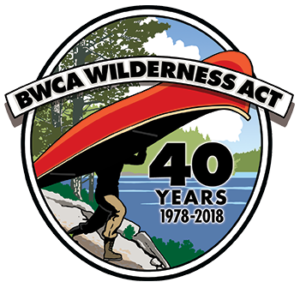BWCA Celebrates 40 Years
From the USFS…
The BWCAW became part of a National Wilderness Preservation System with signing of the 1964 Wilderness Act. According to the Act, Wilderness is “an area where the earth and its community of life are untrammeled by man, where man himself is a visitor who does not remain.” The intent of the Act was to establish wilderness areas that would remain undeveloped “for the use and enjoyment of the American people in such a manner as will leave them unimpaired for future use and enjoyment as wilderness”.
While inclusion in the national wilderness system lent federal protection, intense conflicts continued; most regarding pre-existing uses in the newly designated BWCAW. Following years of debate and compromise, Congress passed legislation to address specific issues related to the BWCAW. Jimmy Carter signed the Boundary Waters Canoe Area Wilderness Act (PL 95-495) on October 21, 1978, adding acreage, establishing the adjacent Mining Protection Area, and amending the national Wilderness Act of 1964, with the purpose to:
(1) protection and manage fish and wildlife “to enhance public enjoyment and appreciation of the unique biotic resources”,
(2) protect and enhance the natural values and environmental quality of the lakes, streams, shorelines and associated forest areas,
(3) maintain high water quality,
(4) minimize,” to the maximum extent possible”, the environmental impacts associated with mineral development,
(5) restore natural conditions to existing temporary roads and prevent further road and commercial development,
(6) provide “orderly and equitable transition from motorized recreational uses to non-motorized recreational use…”
The Act specifically prohibits logging and provides direction to the Forest Service regarding: level of motorized watercraft use, size of motors, quotas for use, motorized/mechanized portages, snowmobile use, location of resorts, and maintenance of dams.
A comprehensive implementation strategy accompanied the BWCAW Act. The Forest Service was authorized to purchase private lands inside the BWCAW and to compensate timber buyers for contracts terminated or modified by the Act. In addition, the Forest Service was to “expedite the intensification of resource management on the national forest” and “development of dispersed outdoor recreation” outside of the BWCAW.
A key aspect of the implementation strategy was cooperation between the Forest Service and other agencies to provide transition assistance to displaced landowners. This included technical and financial assistance to certain commercial resorts and outfitters “to improve economic opportunities for tourism and recreation-related businesses in a manner which is complementary to the management of the Wilderness”.
Following implementation of the BWCAW Act and several years of litigation, the Forest Service established the first BWCAW Management Plan in 1993. Management direction for the Wilderness was later integrated into the 2004 Superior National Forest Land and Resource Management Plan.
To retain its enduring value, various uses in wilderness must be balanced to be compatible with ‘wilderness character’ which is at the core of the wilderness concept. In managing wilderness, the Forest Service does not simply set aside land and leave it alone. As the agency steward, the Forest Service will continue to actively manage the BWCAW to monitor and protect wilderness character, guided by the BWCAW Act, along with the national Wilderness Act and Forest Plan, and with input from engaged citizens today and for many tomorrows.


Leave a Reply
You must be logged in to post a comment.